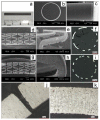Biodegradable metals for cardiovascular stent application: interests and new opportunities
- PMID: 21845076
- PMCID: PMC3155349
- DOI: 10.3390/ijms12074250
Biodegradable metals for cardiovascular stent application: interests and new opportunities
Abstract
During the last decade, biodegradable metallic stents have been developed and investigated as alternatives for the currently-used permanent cardiovascular stents. Degradable metallic materials could potentially replace corrosion-resistant metals currently used for stent application as it has been shown that the role of stenting is temporary and limited to a period of 6-12 months after implantation during which arterial remodeling and healing occur. Although corrosion is generally considered as a failure in metallurgy, the corrodibility of certain metals can be an advantage for their application as degradable implants. The candidate materials for such application should have mechanical properties ideally close to those of 316L stainless steel which is the gold standard material for stent application in order to provide mechanical support to diseased arteries. Non-toxicity of the metal itself and its degradation products is another requirement as the material is absorbed by blood and cells. Based on the mentioned requirements, iron-based and magnesium-based alloys have been the investigated candidates for biodegradable stents. This article reviews the recent developments in the design and evaluation of metallic materials for biodegradable stents. It also introduces the new metallurgical processes which could be applied for the production of metallic biodegradable stents and their effect on the properties of the produced metals.
Keywords: biodegradable stents; coronary stents; electroforming; metallurgical processes.
Figures







References
-
- Bhat SV. Biomaterials. Kluwer Academic Publishers; Boston, MT, USA: 2002. p. 265.
-
- Park JB, Lakes RS. Biomaterials an Introduction. 3rd ed. Springer SpringerLink (Service en ligne); New York, NY, USA: 2007. p. 561.
-
- Witte F. The history of biodegradable magnesium implants: a review. Acta Biomater. 2010;6:1680–1692. - PubMed
-
- Webster TJ. Nanotechnology Enabled in Situ Sensors for Monitoring Health. Springer Verlag; New York, NY, USA: 2010.
-
- Schulz MJ, Shanov VN, Yun Y. Nanomedicine Design of Particles, Sensors, Motors, Implants, Robots, and Devices. Artech House; Boston, MT, USA: 2009.
Publication types
MeSH terms
Substances
LinkOut - more resources
Full Text Sources
Other Literature Sources
Medical

